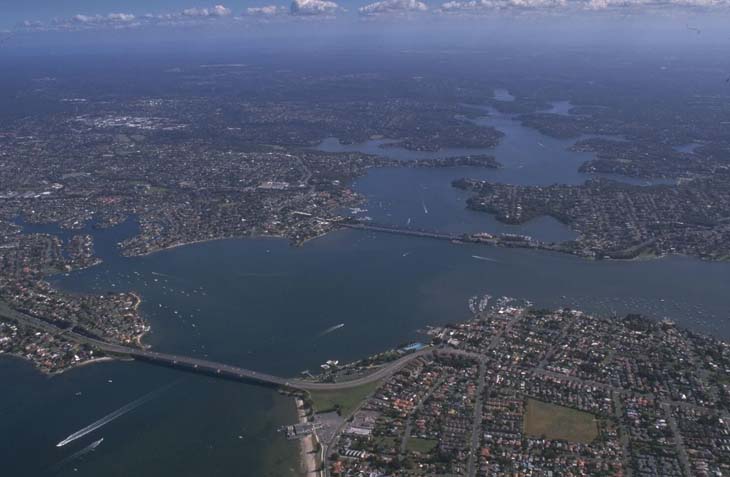Georges River estuary is situated within the Sydney Metropolitan region of New South Wales. This estuary is classed as a drowned river valley and is the main tributary of Botany Bay.
Two large water storages, the Woronora Dam and Prospect Reservoir, are situated in this catchment and are used for Sydney’s water supply. Liverpool Weir defines the upper tidal limit of the Georges River estuary.
Water quality report card
As part of our water quality monitoring program we assess the water quality and ecosystem health of an estuary using a range of relevant indicators. We sample a subset of the estuaries located between Taree and Wollongong every 3 years. The most recent sampling in the Georges River was completed over the 2022–23 summer, when 2 sites were sampled on a monthly basis.
This report card represents 2 water quality indicators that we routinely measure: the amount of algae present and water clarity. Low levels of these 2 indicators equate with good water quality. The numerical scores for these 2 indicators are averaged to give the overall grade.
The report card shows the condition of the estuary was good with:
- algae abundance graded fair (C)
- water clarity graded good (B)
- overall estuary health graded good (B).
Grades for algae, water clarity and overall are represented as:
- A – excellent
- B – good
- C – fair
- D – poor
- E – very poor.
Go to estuary report cards to find out what each grade means, read our sampling, data analysis and reporting protocols, and find out how we calculate these grades.
We have monitored water quality in the Georges River since 2010. This table shows the water quality grades for this estuary over that time.
| Year | Algae | Water clarity | Overall grade |
|---|---|---|---|
| 2022–23 | C | B | B |
| 2019–20 | C | B | C |
| 2016–17 | C | B | B |
| 2013–14 | B | B | B |
| 2010–11 | B | B | B |
Physical characteristics
| Estuary type | Drowned river valley |
|---|---|
| Latitude | –34 (ºS) |
| Longitude | 151.16 (ºE) |
| Catchment area | 930.9 km2 |
| Estuary area | 26.6 km2 |
| Estuary volume | 271,393.5 ML |
| Average depth | 10.5 m |
Tidal exchange volume
Tidal exchange volume or tidal prism data is available for this estuary. This tidal prism was measured in 1991.
| Tide state | Flow (ML) | Local tidal range (m) | Sydney Harbour tidal range (m) |
|---|---|---|---|
| Ebb flow | 19,320 | 1.21 | 1.12 |
| Flood flow | 16,660 | 1.35 | 1.32 |
Notes: km2 = square kilometres; m = metres; m3 = cubic metres; ML = megalitres.
Water depth and survey data
Bathymetric and coastal topography data for this estuary are available in our data portal.
Land use
The catchment of the Georges River has been highly disturbed by a mix of land-use changes. About one-third of the catchment is made up of urban and industrial areas, and a lot of the western catchment has been cleared for grazing, agriculture and horticulture. Undisturbed forest remains in about 40% of the catchment, mostly in the upper catchment.
Water use
Find out about water use in the Georges River, including information about major water users, real-time flow data, and environmental and water sharing plans.
National and marine parks
- Heathcote National Park and Dharawal National Park are the largest conservation areas in this catchment.
- This estuary does not flow into a marine park.
Community involvement
- Georges Riverkeeper is a catchment management group that works with 8 member councils to improve the environment of the Georges River. They raise community awareness about protecting and restoring the natural environment and provide links for volunteers to get involved.
- Greater Sydney Landcare Network is a community organisation and an umbrella group for a host of Landcare organisations in the region. They have a number of projects listed on their website and support volunteers to get involved in work to protect, restore and improve the natural environment of Greater Sydney.
Seafood harvest area status
The NSW Food Authority website lists the current status of oyster/shellfish harvest areas.
Local government management
Local councils manage estuaries within their area. Where an estuary is attached to a marine park, marine park management teams are responsible for ensuring compliance with marine park zoning.
Wollondilly, Campbelltown, Liverpool, Fairfield, Canterbury–Bankstown, Bayside, Sutherland and Georges River councils manage parts of this catchment.
Threatened species
Georges River supports an endangered ecological community of shorebirds on the relict tidal delta sands at Taren Point.
Find out more about the biodiversity in our estuaries.
